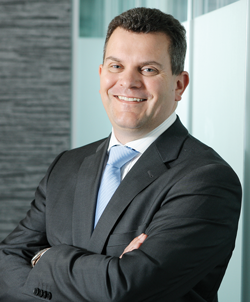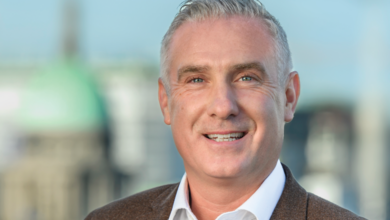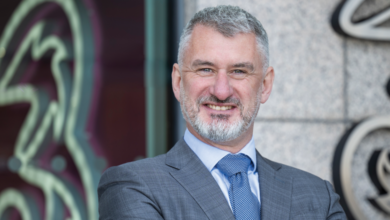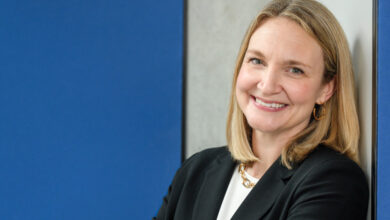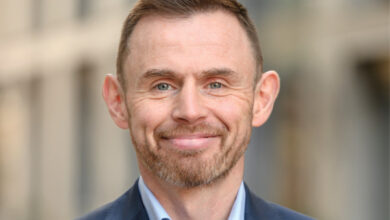Ernst & Young: Survival through transformation
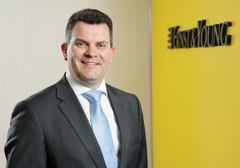 Government needs to seize this opportunity for reform and create a citizen-centric public sector fit for the 21st century. Innovative leadership and mindset will make the difference, Ernst and Young’s Colm Devine tells Owen McQuade.
Government needs to seize this opportunity for reform and create a citizen-centric public sector fit for the 21st century. Innovative leadership and mindset will make the difference, Ernst and Young’s Colm Devine tells Owen McQuade.
The Irish Public Service is faced with a situation whereby costs must continue to be reduced and reform should be accelerated. Although there have been encouraging moves within the public sector, there are many areas where reform has not happened at the scale required. All government departments must now ensure that true reform is implemented in order to achieve a world-class Public Service across the island of Ireland, Ernst and Young’s Head of Government Services, Colm Devine tells eolas.
Devine sees “some exceptional talent in the leadership of the Civil Service and a workforce experiencing a lot of pressure on many fronts, which can create mixed motivations for change.” There is an opportunity “to create a race to the top for the country, using this talent to readjust the shape of government departments and the services they provide.” Strong leaders must emerge to “create the public service of the future.” Like any performance-driven organisation, public service leaders need to incentivise success, creating a culture of improvement, innovation and one of challenge, for those who do not take advantage of the opportunities being offered to them.
Ireland is viewed as a good citizen within Europe for the austerity steps taken in the road to recovery. Devine notes that “Ireland can continue this journey in terms of government benchmarks and how they create a public sector in Ireland that is fit for the future.”
He emphasises: “We need to pull through the best ideas and talent and allow the public and private sectors to work together without constraint. An innovative and collaborative approach to public service delivery can reduce costs, raise productivity and improve the public’s opinion of government.”
Devine recommends two key themes for Public Service reform:
• funding the future; and
• good governance and transparency.
Funding the future
Funding the future involves investing in entrepreneurship and partnership, Devine explains. Ireland has built a strong foundation of support for entrepreneurs but there are many ingredients required to improve entrepreneurial growth including access to funding, education, collaboration and taxation.
“The Government’s that have made the best progress are those who have invested huge resources in entrepreneurship and change,” he says.
While access to funds is a constraint in this regard, Devine points out that “there are ways of achieving this [e.g.] allowing the public and private sector to innovate collaboratively, and examine whether some services should be provided through public or private sector organisations, [thereby] enabling a leverage impact and creating new private sector organisations.” Moves must be made so that government officials can make such decisions without fear of a backlash, according to the change management expert.
He points to Canada and Japan, where “innovative investment” has helped them onto the path of recovery from “a troubled economy.” Investors are attracted to Canada’s favorable R&D tax credits and incentives such as open government procurement practices, effective protection of intellectual property rights, open competition in the domestic market in the deployment of digital ICT, and openness to high-skill immigration.
The Government of Japan has launched a series of initiatives under its ‘Inward Investment Promotion Program’, including a subsidy programme for Asian site location (offering a 20 per cent corporate income tax deduction for five years, SME patent fees reduced by half for certified R&D operations, and expedited immigration procedures.)
A comprehensive special zones and immigration system will incentivise rural revitalisation (e.g. through investment tax credits when acquiring assets such as machinery and buildings) and strengthen the international competitiveness of Japanese companies.
“The private sector has a high degree of interest in trying to bring innovation into the Irish economy and Irish Public Service,” Devine states. “When balancing this with good standards of public financial management, governance and risk, innovation does work.” A good understanding of fiscal responsibility is “essential”.
“Government departments are given budgets and they have a service provision requirement in terms of how they spend it. But, are they always getting the best bang for their buck?” he wonders.
Giving officials the ability to challenge the services they are receiving for the money they are spending is essential. Commercial excellence, something which Ernst and Young has rolled out with other governments, can help reset the bar, Devine contends.
However, officials with fiscal responsibility who decide against taking the opportunity to innovate “really need to challenge themselves and consider the possibilities.” He insists: “That’s a culture that needs to change.”
Ernst and Young recommends that senior government leaders “create a culture of partnership and innovation which does consider the consequences of not taking risks,” adding that “this is something that they haven’t been used to in some areas of government.”
There is always room for improvement around governance, Devine believes. “You’ve got to have a good governance mechanism that presents more opportunities for innovation and more opportunities to challenge where money is spent. You also need governance to protect those decisions too,” he explains.
Transparency is crucial to moving forward with reform. “If you’ve got fiscal responsibility with good governance and are prepared to be transparent about your decision making process, together with investing in innovation and change, you would hope that would arm officials with the ability to do things.”
Devine acknowledges that “not all decisions will be good,” but counteracts that “at least you can demonstrate why you’ve made the decisions.”
Ernst and Young have invested heavily in working with governments on leadership, cost saving and creating paths to making a difference. It is essential to remember that “the skills required in a healthy economic environment are completely different to those in a troubled environment. Every day does count.” Excellent programme management and a clear view on the benefits is essential. A “citizen-centred strategy helps break out of the silo mentality,” he proposes.
Walking from one government department to another, Devine notices that “there are various connection points where the many areas of government speak to each other. However we don’t have an integrated service focused on the citizen; it has never been designed that way.”
He recognises that strides are being made in terms of shared services and the ability to collaborate across departments, “but they tend to be back office orientated or focused on the Civil Service, not Public Service.”
Ultimately, he explains: “We are trying to provide a service to the citizens, so how do you break down those silos and provide the management teams with that culture and mindset which are incentivised to reform?”
Again, he points to Canada, where Service Canada was created in 2005 to improve the delivery of government programs and services to Canadians, by making access to them faster, easier, and more convenient.
Overall, that Government had been finding it expensive and difficult to manage an ageing and siloed service infrastructure.
As an example, Service Canada created a citizen-centred service strategy for people with disabilities, which was in turn replicated to other parts of the Canadian system. Previous disability services had been “confused and expensive” consisting of three departments, provincial territorial organisations and the third sector taking responsibility for 19 service areas. These, in turn, had multiple channels of contact.
The drivers for change were to segment customers and examine the services being provided, Devine explains. “We regularly find that government provide services that are not statutorily responsible. This then creates choices for government.”
Service Canada’s approach looked at the citizen first, the types of services that are required and then formulated an integrated channel of contact i.e. phone, in person, internet or mail. They also challenged what they should not be doing.
“Not only was service improved, leadership mindset had completely changed and it saved a lot of money. So you had a happier citizen costing less money,” Devine explains.
Service transformation
According to Devine, government officials should concentrate on the following service transformation goals:
• delivering a seamless citizen-centred service by providing an integrated, one-stop service based on citizen needs and helping to deliver better policy outcomes;
• enhancing the integrity of change by building trust and confidence in government transformation programmes;
• working as a collaborative government by building a whole-of-government approach to services that enable information sharing and integrated service delivery for the benefit of citizens;
• demonstrating accountable and responsive government by delivering results for citizens and government, savings for tax payers and transparency in reporting; and
• building a culture of service excellence by supporting our people, encouraging innovation and building the leadership and capacity to provide a citizen-centred service.
When thinking about service transformation it is important to consider that almost 70 per cent of programmes do not deliver their intended benefits, Devine tells eolas.
“In order to enhance the integrity of a programme, you need to invest heavily upfront to find yourself in that 30 per cent success segment. It is about making sure the mandate is clear, has leadership buy-in and has sufficient skills and innovation,” he claims. There are leaders in the Public Service trying to achieve this, but they need more support.
A whole of government approach “must start by asking do we need all the departments we have and should they be shaped the way they are?” Again, we see examples of this with the current government, such as how we are thinking about reorganising how we deliver services to our children.
In designing a citizen-centred solution, constraints will have to be overcome and that will take time. However, Devine contends that “there are areas where they could take more risks, where pace and outcomes can be improved.”
In the short term, “some of the red tape constraint in government could be managed to embrace further opportunity for public and private sectors working together.”
At the moment, the general view is that funding for invest-to-save projects is difficult, “the finances of Ireland are under such pressure, they don’t really have that money to spend-to-save.” That’s when public-private partnerships and other shared savings mechanisms should be considered much more vigorously, Devine states.
Overall, “the Government’s role in addition to its sovereign responsibilities is delivering affordable services to the customer and building an approach which is fit for the future, creates an asset for Ireland to attract inbound investment, but is also accountable to our citizens in building a culture of service excellence.”
In order to reach this ideal, it must be prepared to “challenge norms” and consider the possibility of legislative change as they did in Canada. This is essential if government is to “really embrace innovation.”
The reform agenda “is about survival through transformation, allowing our leaders to innovate, making the days count and delivering a service fit for our future.”
Colm Devine, Head of Government Services, Ernst and Young
Belfast-born Devine studied at La Salle Boys School, before completing a BA Hons accounting and computing degree at the University of Ulster. He is a member of the Chartered Institute of Securities and Investments (corporate finance, securities and investments) and is a fellow of the Institute of Chartered Accountants in Ireland.
He has experience of working with governments and global organisations in their transformation over the past 21 years. He has held positions in New York, London, Belfast and now Dublin, previously heading up Ernst & Young’s UK risk practice outside of London.
In his spare time, he enjoys spending time with his two children, water-skiing and golf.

